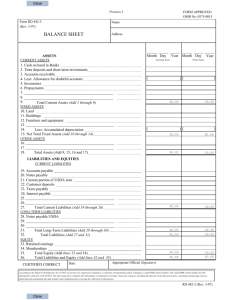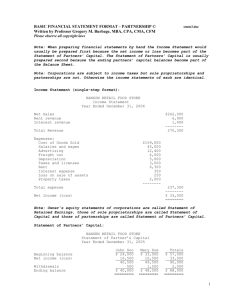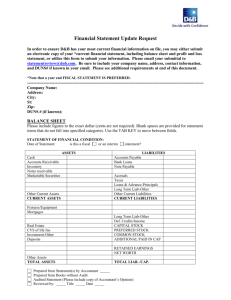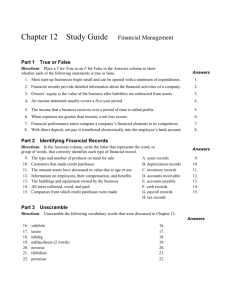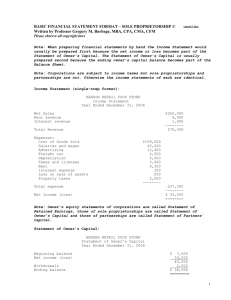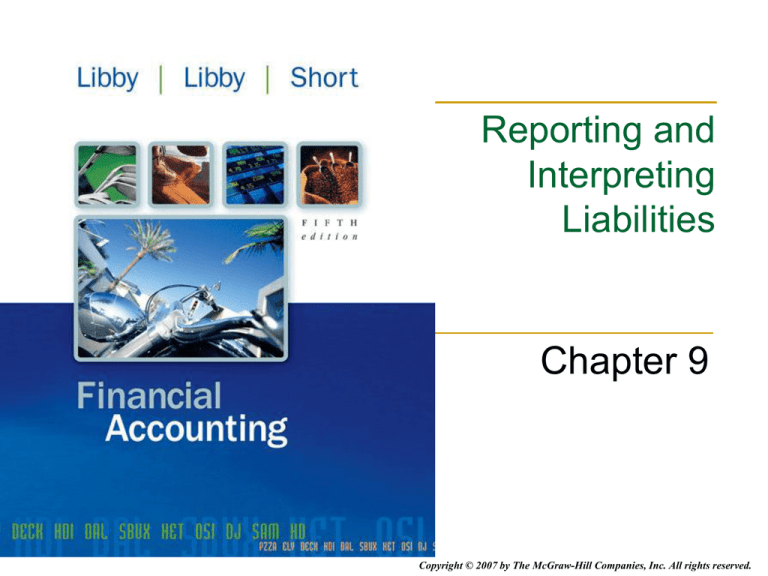
Reporting and
Interpreting
Liabilities
Chapter 9
Copyright © 2007 by The McGraw-Hill Companies, Inc. All rights reserved.
9-2
Understanding the Business
The acquisition of assets is financed from two
sources:
Debt - funds
from creditors
Equity - funds
from owners
9-3
Understanding the Business
Debt is considered riskier than equity.
Interest is
a legal
obligation.
Creditors
can force
bankruptcy.
9-4
Learning Objectives
Define, measure, and report current liabilities.
9-5
Liabilities Defined and Classified
Defined as probable debts or obligations of the
entity that result from past transactions, which will
be paid with assets or services.
Maturity = 1 year or less
Maturity > 1 year
Current
Liabilities
Noncurrent
Liabilities
9-6
Liabilities Defined and Classified
Liabilities are measured
at their current cash
equivalent (the amount
a creditor would accept
to cancel the debt) at
the time incurred.
9-7
Current Liabilities
Account
Name
Accounts
Payable
Accrued
Liabilities
Notes
Payable
Deferred
Revenues
Also
Called
Trade
Accounts
Payable
Definition
Obligations to pay for goods and
services used in the basic operating
activities of the business.
Obligations related to expenses that
Accrued
have been incurred, but will not be
Expenses
paid until the subsequent period.
Obligations due supported by a formal
N/A
written contract.
Obligations arising when cash is
Unearned
received prior to the related revenue
Revenues
being earned.
9-8
Payroll Taxes
Gross Pay
Net Pay
Less Deductions:
Social
Security
Tax
Medicare
Tax
Federal
Income Tax
State and
Voluntary
Local Income Deductions
Taxes
9-9
Learning Objectives
Use the current ratio.
9-10
Current Ratio
An important indicator of a company’s ability to
meet its current obligations.
Current Ratio = Current Assets ÷ Current Liabilities
Starbucks has current assets of
$924 and current liabilities of
$608.7.
Current
=
Ratio
1.52 =
Current
Assets
÷
Current
Liabilities
$924.00 ÷
$608.70
2003 Current Ratios
Panera
Krispy
Starbucks Bread
Kreme
1.52
1.53
1.94
9-11
Learning Objectives
Analyze the accounts payable turnover ratio.
9-12
Accounts Payable Turnover Ratio
Measures how quickly management is paying
trade accounts.
Accounts
Payable =
Turnover
Cost of
Average
Goods ÷ Accounts
Sold
Payable
Starbucks has cost of goods sold
of $1,685.9 and average accounts
payable of $152.5.
Accounts
Payable =
Turnover
11.06 =
Cost of
Goods
Sold
Average
÷ Accounts
Payable
$1,685.90 ÷
$152.50
2003 Accounts Payable Turnover Ratios
Starbucks
11.00
Panera
Bread
9.29
Krispy
Kreme
N/A
9-13
Learning Objectives
Report notes payable and explain the time
value of money.
9-14
Notes Payable
A note payable specifies the interest
rate associated with the borrowing.
To
the lender, interest is a revenue.
To the borrower, interest is an expense.
Interest = Principal × Interest Rate × Time
When computing interest for one
year, “Time” equals 1. When the
computation period is less than
one year, then “Time” is a fraction.
9-15
Notes Payable
Starbucks borrows
$100,000 for 2 months at
an annual interest rate
of 12%. Compute the
interest on the note for
the loan period.
Interest
Interest
Interest
= Principal
= $ 100,000
= $ 2,000
× Interest Rate ×
×
12%
×
Time
2
/12
9-16
Learning Objectives
Report contingent liabilities.
9-17
Contingent Liabilities
Potential liabilities that arise because of events
or transactions that have already occurred.
Probability of future sacrifice . . .
Reasonably
Probable
Possible
Remote
Amount
Can be
Estimated
Amount
Cannot be
Estimated
Record
contingent
Disclose
liability in the
No
liability.
notes to the
action.
Disclose
liability in the
financial stmts.
Disclose
liability in the
No
notes to the
notes to the
action.
financial stmts. financial stmts.
9-18
Learning Objectives
Explain the importance of working capital and
its impact on cash flows.
9-19
Working Capital Management
Working Capital = Current Assets - Current Liabilities
Changes in working capital accounts affect
cash flows as indicated in the following
table.
Current
Assets
Current
Liabilities
Change in Account Balance During Year
Increase
Decrease
Reduce cash
Increase cash
flows.
flows.
Increase cash
Reduce cash
flows.
flows.
9-20
Learning Objectives
Report long-term liabilities.
9-21
Long-Term Liabilities
Creditors often require the borrower to
pledge specific assets as security for
the long-term liability.
Maturity = 1 year or less
Maturity > 1 year
Current
Liabilities
Long-term
Liabilities
9-22
Long-Term Notes Payable and Bonds
Relatively small debt
needs can be filled from
single sources.
Banks
Insurance
Companies
or
Pension
Plans
9-23
Long-Term Notes Payable and Bonds
Significant debt needs are
often filled by issuing
bonds to the public.
Bonds
Cash
9-24
Borrowing in Foreign Currencies
When a company has operations in a foreign
country, it often borrows in the local currency.
This reduces exchange rate risk.
Because interest rates vary from country to
country, companies may borrow in the foreign
market with the lowest interest rate.
9-25
Operating and Capital Leases
Operating
Lease
Capital
Lease
Long-term lease;
Short-term lease; No
Meets one of 4
liability or asset
criteria; Results in
Capital Lease
Criteria
recorded
recording an asset
1. Lease term is 75% or more of the asset’s expected economic life.
a liability
2. Ownership of asset is transferred to lessee at endand
of lease.
3. Lease permits lessee to purchase the asset at a price that is lower than its
fair market value.
4. The present value of the lease payments is 90% or more of the fair market
value of the asset when the lease is signed.
9-26
Learning Objectives
Compute present values.
Apply present value concepts to liabilities.
9-27
Present Value Concepts
$1,000
invested
today at 10%.
In 5 years it
will be worth
$1,610.51.
In 25 years it
will be worth
$10,834.71!
Money can grow over time,
because it can earn interest.
9-28
Present Value Concepts
1.
2.
3.
4.
The growth is a mathematical
function of four variables:
The value today (present value).
The value in the future (future
value).
The interest rate.
The time period.
9-29
Present Value Concepts
Most analysts use present value
tables, calculators, or Excel to solve
time value of money problems.
We will use the present value tables in
our illustrations (an explanation of
how to use Excel is included in the
supplement to this chapter).
9-30
Present Value of a Single Amount
The present value of a single amount is
the worth to you today of receiving that
amount some time in the future.
Present
Value
Future
Value
Interest compounding periods
Today
Future
9-31
Present Value of a Single Amount
a.
b.
c.
d.
How much do we need to invest today at 10%
interest, compounded annually, if we need $1,331
in three years?
$1,000.00
$ 990.00
$ 751.30
$ 970.00
9-32
Present Value of a Single Amount
a.
b.
c.
d.
How much do we need to invest today at 10%
interest, compounded annually, if we need $1,331
in three years?
$1,000.00
$ 990.00
The required future amount is $1,331.
$ 751.30
i = 10% & n = 3 years
Using the present value of a single
$ 970.00
amount table, the factor is .7513.
$1,331 × .7513 = $1,000 (rounded)
9-33
Present Values of an Annuity
An annuity is a series of consecutive
equal periodic payments.
Today
9-34
Present Values of an Annuity
What is the value today of a series of
payments to be received or paid out in
the future?
Payment 1
Present
Value
Today
Payment 2
Interest compounding periods
Payment 3
9-35
Present Values of an Annuity
What is the present value of receiving $1,000 each
year for three years at an interest rate of 10%,
compounded annually?
a. $3,000.00
b. $2,910.00
c. $2,700.00
d. $2,486.90
9-36
Present Values of an Annuity
What is the present value of receiving $1,000 each
year for three years at an interest rate of 10%,
compounded annually?
a. $3,000.00
b. $2,910.00
c. $2,700.00
The consecutive equal payment
amount is $1,000.
d. $2,486.90
i = 10% & n = 3 years
Using the present value of an
annuity table, the factor is 2.4869.
$1,000 × 2.4869 = $2,486.90
9-37
Accounting Applications of Present Values
On January 1, 2006, Starbucks bought some new
delivery trucks. The company signed a note
agreeing to pay $200,000 on December 31, 2007.
The market interest rate for this note is 12%.
Future value
$ 200,000
PV of $1
(i=12%, n=2)
Present value
×
0.79720
$ 159,440
Let’s prepare the journal entry to record the purchase.
9-38
Accounting Applications of Present Values
GENERAL JOURNAL
Date
Description
Jan. 1 Delivery trucks
Notes payable
Debit
159,440
Credit
159,440
Present
Interest
Rate
Interest 31,
Now, let’s
look Value
at the ×journal
entry
at =December
$159,440 2006.
× 12% = $19,133
GENERAL JOURNAL
Date
Description
Dec. 31 Interest expense
Notes payable
Debit
19,133
Credit
19,133
9-39
Accounting Applications of Present Values
Now, let’s look at the journal entries at December 31,
2007.
GENERAL JOURNAL
Description
Date
Dec. 31 Interest expense
Notes payable
31 Notes payable
Cash
Debit
21,429
Credit
21,429
200,000
200,000
Present Value × Interest Rate = Interest
($159,440 + $19,133) × 12% = $21,429
9-40
Chapter Supplement A
Income Taxes and Retirement
Benefits
9-41
Income Taxes and Retirement Benefits
Deferred Taxes
Exist because of timing differences
caused by reporting revenues and
expenses according to GAAP on a
company’s income statement and
according to the Internal Revenue
Code on the tax return.
Temporary
Differences
Timing differences that cause
deferred income taxes and will
reverse, or turn around, in the
future.
9-42
Income Taxes and Retirement Benefits
Some pension plans
create obligations during
employees’ service periods
that must be paid during
their retirement periods.
The amounts contributed
during the employment
period are determined
using present value
computations of the
estimate of the future
amount to be paid during
retirement.
9-43
Chapter Supplement B
Federal Income Tax Concepts
9-44
Federal Income Tax Concepts
Corporations
Are separate legal entities and
are required to pay income
taxes.
Tax Obligation
Determined by multiplying
taxable income by the corporate
tax rate.
9-45
Revenue and Expense Recognition for
Income Tax Purposes
1. Interest revenue on state and municipal bonds is generally
excluded from taxable income although it is included in
accounting income.
2. Revenue collected in advance is included in taxable income when
it is collected and in accounting income when it is earned.
3. Proceeds from life insurance policies are excluded from taxable
income but included in accounting income.
4. Corporations that own less than 20% of another corporation’s
stock may exclude 70% of the dividends received from taxable
income, although all dividends are included in accounting income.
5. For tax purposes, depreciation expense is generally based on the
Accelerated Cost Recovery System (ACRS) or on the Modified
Accelerated Cost Recovery System (MACRS).
9-46
Tax Minimization Versus Tax Evasion
9-47
Chapter Supplement C
Present Value Computations
Using Excel
9-48
Present Value Computations Using Excel
Present Value of A Single Amount Formula
= Payment/(1 + i)^n
Present Value of An Annuity Formula
Use the present value of an annuity formula
programmed in Excel by selecting the
function button (fx ). In the drop down
menu, under the Select Category heading,
pick "Financial" and scroll down under
Select Function and click on "PV." In the
new drop down box, enter the specific
information for your problem and click
"OK."
9-49
Chapter Supplement D
Future Value Concepts
9-50
Future Value of a Single Amount
Future value is the sum to which an amount will
increase as the result of compound interest.
How much will an amount today be worth in the
future?
Present
Value
Today
Interest compounding periods
Future
Value
9-51
Future Value of a Single Amount
a.
b.
c.
d.
If we invest $1,000 today earning 10% interest,
compounded annually, how much will it be worth
in three years?
$1,000
$1,010
$1,100
$1,331
9-52
Future Value of a Single Amount
a.
b.
c.
d.
If we invest $1,000 today earning 10% interest,
compounded annually, how much will it be worth
in three years?
$1,000
$1,010
The invested amount is $1,000.
$1,100
i = 10% & n = 3 years
$1,331
Using the future value of a single
amount table, the factor is 1.331.
$1,000 × 1.331 = $1,331
9-53
Future Value of an Annuity
Equal payments are made each period.
The payments and interest accumulate over time.
Payment 1
Payment 2
Interest compounding periods
Today
Payment 3
9-54
Future Value of an Annuity
a.
b.
c.
d.
If we invest $1,000 each year at an interest rate
of 10%, compounded annually, how much will we
have at the end of three years?
$3,000
$3,090
$3,300
$3,310
9-55
Future Value of an Annuity
a.
b.
c.
d.
If we invest $1,000 each year at an interest rate
of 10%, compounded annually, how much will we
have at the end of three years?
$3,000
$3,090
$3,300
The annual investment amount is $1,000.
$3,310
i = 10% & n = 3 years
Using the future value of an annuity
table, the factor is 3.3100.
$1,000 × 3.3100 = $3,310
9-56
End of Chapter 9


